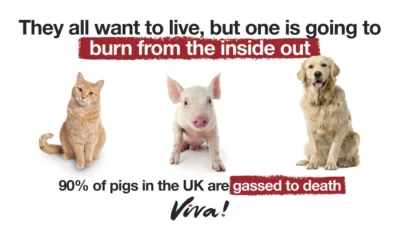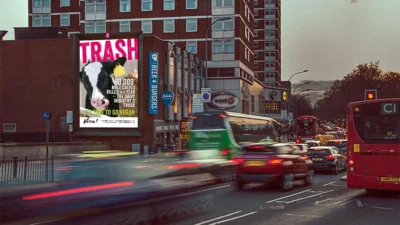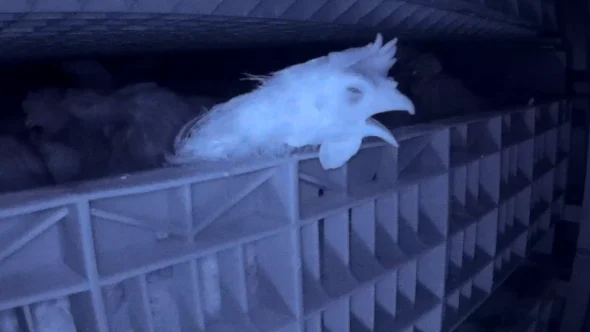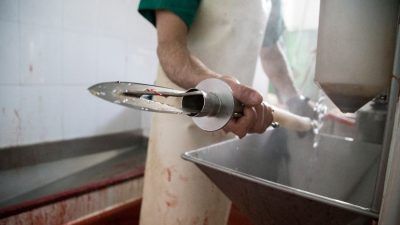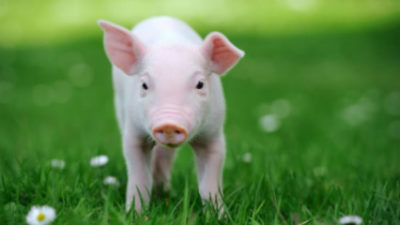Pig Gassing in the UK
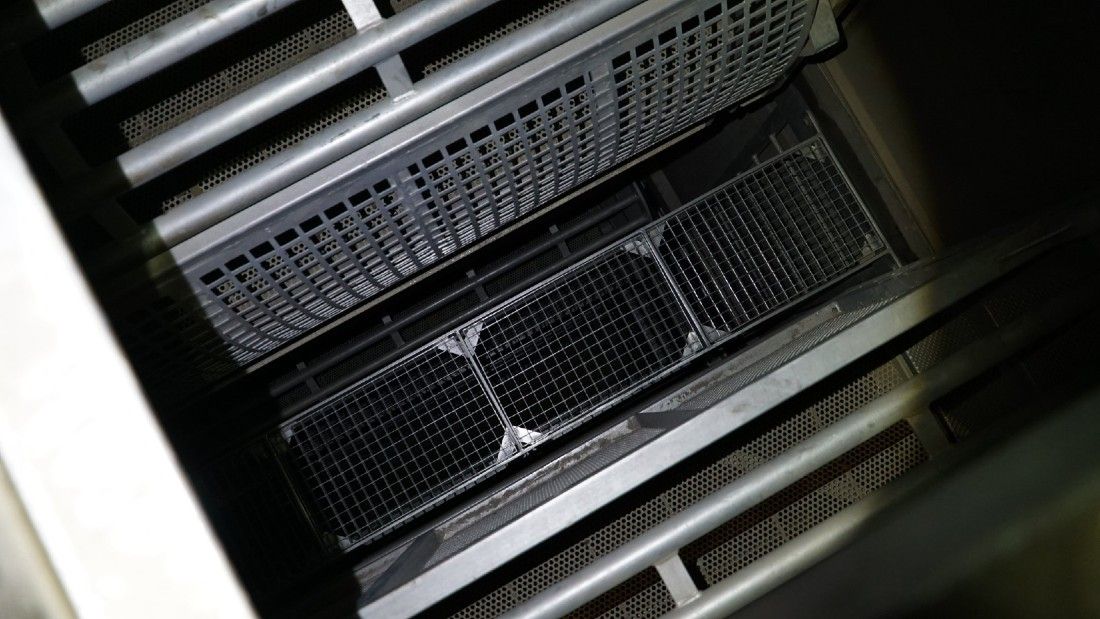
90 per cent of pigs in the UK are killed by gassing. It causes agony as the carbon dioxide (CO2) gas forms an acid on their eyes, nostrils, mouths and lungs.
In the UK, 10 million pigs are slaughtered for meat every year.1Defra. 2025. Agriculture in the United Kingdom 2024. Available at: https://www.gov.uk/government/statistics/agriculture-in-the-united-kingdom-2024/chapter-8-livestock [Accessed 18 November 2025]. Most of these highly intelligent sentient beings spend the majority of their miserable lives indoors; confined to filthy overcrowded sheds before heading to slaughter at just five to six months old. Find out more about how pigs are farmed and killed here.
Approved slaughterhouses
The Food Standards Agency (FSA) and Food Standards Scotland (FSS) are responsible for food safety and food hygiene in England, Wales, Northern Ireland and the latter in Scotland. They work with local authorities to enforce food safety regulations and ensure meat plants operate to the legal standard. Together, they monitor over 250 slaughterhouses* – just under half of which have the means to slaughter pigs.
*In November 2025, the FSA and FSS datasets listed 208 slaughterhouses in England and Wales, 20 in Northern Ireland and 23 in Scotland. Due to the changing nature of the industry (and seasonal slaughter establishments) these figures are regularly updated and published online at: https://www.food.gov.uk/business-guidance/approved-food-establishments
Stunning and slaughter
Prior to all standard (non-religious) slaughter, pigs are stunned; either through exposure to high concentration gas (which also kills them) or electronarcosis to the head (which is meant to stun the pig long enough for them to remain unconscious whilst being bled to death).
A slaughter survey, carried out between 12 to 18 February 2024, by the FSA indicates that in England and Wales 90 per cent of pigs are stunned with high concentration CO2; up from 88 per cent in 2022.2Defra. 2025. Results of the 2024 FSA Slaughter Sector Survey in England and Wales. Available at https://assets.publishing.service.gov.uk/media/67c5cf0e750837d7604dbdbf/25-02-14_Slaughter_Sector_Survey_2024__REVISED_.pdf [Accessed 18 November 2025]. Almost all the remaining 10 per cent are stunned by electronarcosis; a fully reversible procedure that disrupts normal brain function for a short period.
Gas stunning is otherwise known as ‘controlled atmospheric stunning’ and involves using an environment with a high concentration of gas, predominantly CO2, which causes an animal to lose consciousness and die. In the limited published studies available to date, induction times for unconsciousness with high concentration CO2 ranges from 21 to 60 seconds but may be longer.3Animal Welfare Committee (AWC). 2025. Opinion on the welfare impacts on pigs of high concentration CO2 gas stunning and of potential alternative stunning methods. Available at: https://www.gov.uk/government/publications/opinion-on-carbon-dioxide-gas-stunning-of-pigs-and-alternative-methods/opinion-on-the-welfare-impacts-on-pigs-of-high-concentration-co2-gas-stunning-and-of-potential-alternative-stunning-methods#high-concentration-cosub2sub-stunning [Accessed 18 November 2025].
See Direct Action Everywhere’s 3D reconstruction of a Marel stunning chamber below.4Greenburg A. 2023. Spy cams reveal the grim reality of slaughterhouse gas chambers. Wired 18 January. Available at https://www.wired.com/story/dex-pig-slaughterhouse-gas-chambers-videos/ [Accessed 18 November 2025].
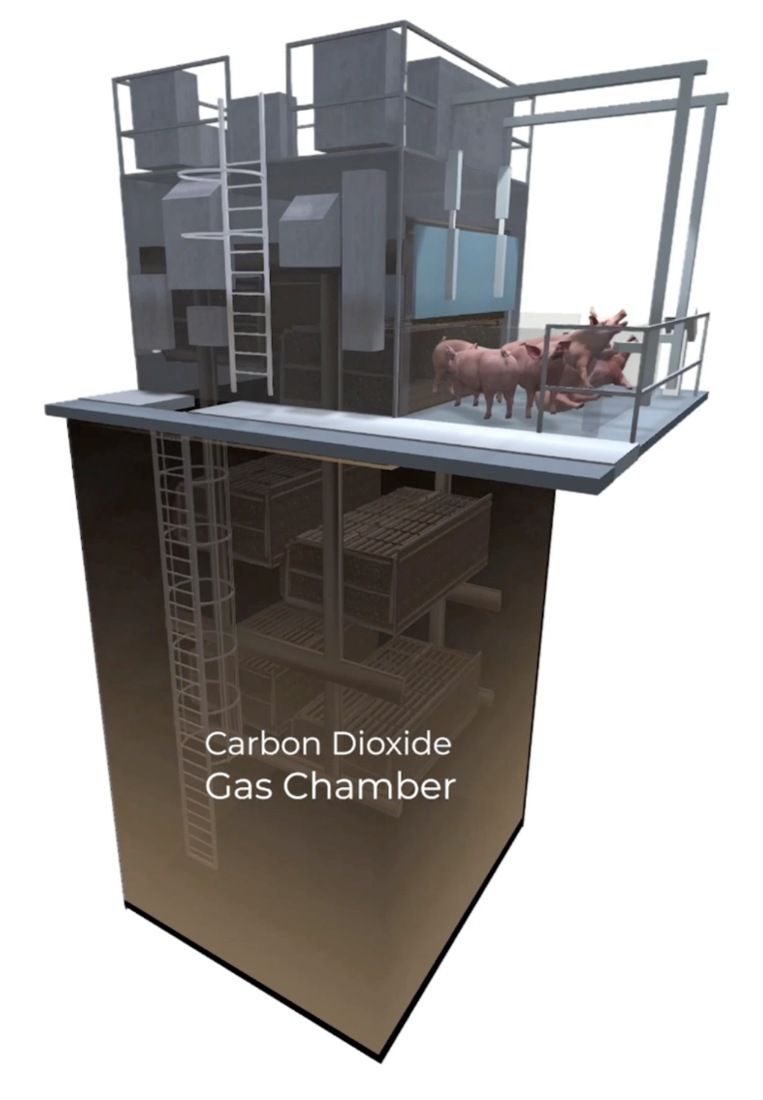
Pigs are herded into a cage called a gondola in groups of five to seven and then lowered into the gas chamber.3Animal Welfare Committee (AWC). 2025. Opinion on the welfare impacts on pigs of high concentration CO2 gas stunning and of potential alternative stunning methods. Available at: https://www.gov.uk/government/publications/opinion-on-carbon-dioxide-gas-stunning-of-pigs-and-alternative-methods/opinion-on-the-welfare-impacts-on-pigs-of-high-concentration-co2-gas-stunning-and-of-potential-alternative-stunning-methods#high-concentration-cosub2sub-stunning [Accessed 18 November 2025]. It’s a paternoster style system with multiple gondolas on a motorised loop, like a Ferris wheel. Government guidance states that once in the stunner, the animals must be conveyed to the maximum concentration of gas within 30 seconds of entering.5Defra. 2015. Red meat slaughterhouses: restraining, stunning and killing animals. Available at: https://www.gov.uk/guidance/red-meat-slaughterhouses-restraining-stunning-killing-animals#gas-stunning [Accessed 18 November 2025]. Since CO2 is heavier than air, the maximum concentration is therefore always at the bottom.3Animal Welfare Committee (AWC). 2025. Opinion on the welfare impacts on pigs of high concentration CO2 gas stunning and of potential alternative stunning methods. Available at: https://www.gov.uk/government/publications/opinion-on-carbon-dioxide-gas-stunning-of-pigs-and-alternative-methods/opinion-on-the-welfare-impacts-on-pigs-of-high-concentration-co2-gas-stunning-and-of-potential-alternative-stunning-methods#high-concentration-cosub2sub-stunning [Accessed 18 November 2025].Workers are also required to make sure that no pig enters the gas stunner if the CO2 concentration by volume falls below 80 per cent.5Defra. 2015. Red meat slaughterhouses: restraining, stunning and killing animals. Available at: https://www.gov.uk/guidance/red-meat-slaughterhouses-restraining-stunning-killing-animals#gas-stunning [Accessed 18 November 2025].
As the gondola is lowered, the pigs will begin to show strong reactions – screaming and thrashing around violently trying to escape. This is because exposure to high concentrations of CO2 is known to be aversive to pigs and to cause them pain and distress before they become unconscious.
The government’s Animal Welfare Committee says: “Exposure to high concentrations of CO2 in commercial systems causes pigs to suffer pain, respiratory distress and fear as demonstrated through escape behaviour, gasping and vocalisation”.3Animal Welfare Committee (AWC). 2025. Opinion on the welfare impacts on pigs of high concentration CO2 gas stunning and of potential alternative stunning methods. Available at: https://www.gov.uk/government/publications/opinion-on-carbon-dioxide-gas-stunning-of-pigs-and-alternative-methods/opinion-on-the-welfare-impacts-on-pigs-of-high-concentration-co2-gas-stunning-and-of-potential-alternative-stunning-methods#high-concentration-cosub2sub-stunning [Accessed 18 November 2025]. In other words, they panic, scream and try, desperately, to escape.
Inhalation of high concentrations of CO2 causes pain because the gas dissolves in the mucous membranes that line the eyes, nose, mouth and lungs, forming carbonic acid. This acid irritates specialised nerve receptors called nociceptors, triggering the sensation of pain which would feel like burning from the inside out.3Animal Welfare Committee (AWC). 2025. Opinion on the welfare impacts on pigs of high concentration CO2 gas stunning and of potential alternative stunning methods. Available at: https://www.gov.uk/government/publications/opinion-on-carbon-dioxide-gas-stunning-of-pigs-and-alternative-methods/opinion-on-the-welfare-impacts-on-pigs-of-high-concentration-co2-gas-stunning-and-of-potential-alternative-stunning-methods#high-concentration-cosub2sub-stunning [Accessed 18 November 2025].
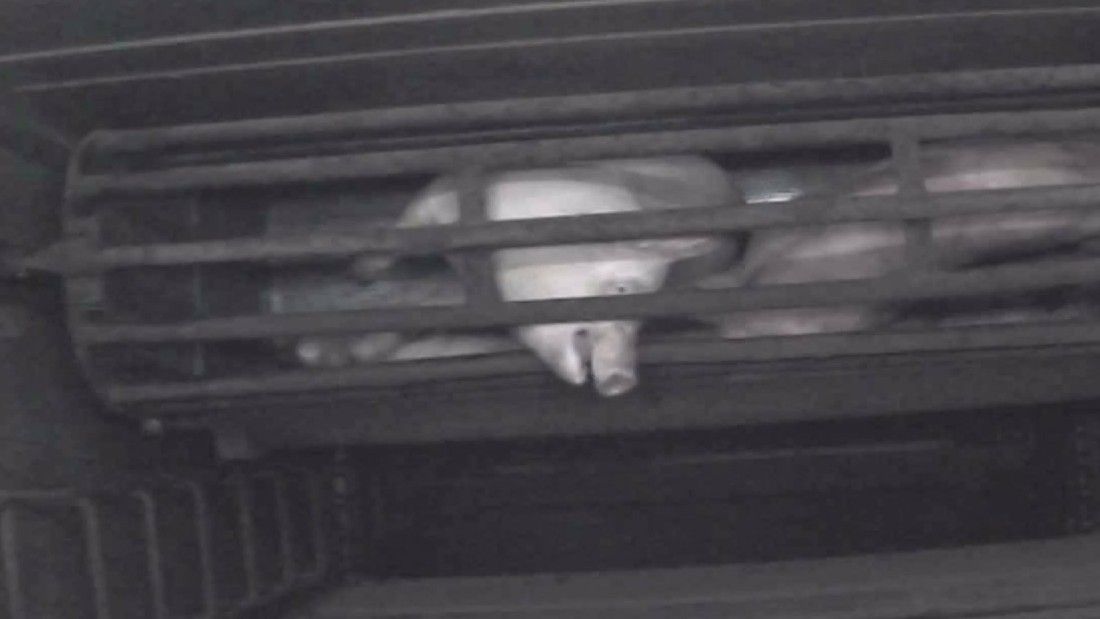
In 2003, the government’s Farm Animal Welfare Council (FAWC), [renamed the Animal Welfare Committee (AWC) in 2019], acknowledged the distress CO2 gassing causes pigs and concluded that: “The use of high concentrations of CO2 to stun and kill pigs is not acceptable and we wish to see it phased out in five years.”6Farm Animal Welfare Council. 2003. FAWC report on the welfare of farmed animals at slaughter or killing. Available at: https://www.gov.uk/government/publications/fawc-report-on-the-welfare-of-farmed-animals-at-slaughter-or-killing [Accessed 18 November 2025].
In 2004, the European Food Safety Authority (EFSA) echoed its concerns, saying: “At concentrations above 30% CO2, the gas is known to be aversive and cause hyperventilation and irritation of the mucous membranes that can be painful and elicits hyperventilation and gasping before loss of consciousness.”.7European Food Safety Authority (EFSA). 2004. Opinion of the Scientific Panel on Animal Health and Welfare on a request from the Commission related to welfare aspects of the main systems of stunning and killing the main commercial species of animals’. EFSA Journal. 45, 1-29. Available at: https://efsa.onlinelibrary.wiley.com/doi/epdf/10.2903/j.efsa.2004.45 [Accessed 18 November 2025]. Twenty years later, EFSA repeated its concerns, describing how exposure of conscious pigs to high concentrations of CO2 is known to be both aversive to pigs and to cause them severe pain and distress before becoming unconscious.8European Food Safety Authority (EFSA). 2020. Welfare of pigs at slaughter. EFSA Journal. 18 (6) 6148. Available at: https://efsa.onlinelibrary.wiley.com/doi/epdf/10.2903/j.efsa.2020.6148 [Accessed 18 November 2025].
In 2025, the AWC released another report on the welfare impacts on pigs of CO2 gas stunning and concluded that: “Since 2003 there have been no significant alterations to systems deploying high concentration CO2 for the stunning of pigs and there is evidence that pigs are subject to avoidable pain, distress or suffering.”9Animal Welfare Committee (AWC). 2025. Opinion on the welfare impacts on pigs of high concentration CO2 gas stunning and of potential alternative stunning methods. Available at: https://www.gov.uk/government/publications/opinion-on-carbon-dioxide-gas-stunning-of-pigs-and-alternative-methods [Accessed 27 November 2025].[Accessed 18 November 2025].
The RSPCA has also voiced its opposition, stating: “The RSPCA is deeply concerned about the use of high concentration CO2 for stunning/killing pigs due to its aversive effects.”10RSPCA. 2025. RSPCA Position: the use of high concentration carbon dioxide (CO2) in the stunning/killing of pigs. Available at: https://science.rspca.org.uk/documents/d/science/rspca-position-on-the-use-of-high-concentration-carbon-dioxide-in-the-killing_stunning-of-pigs [Accessed 27 November 2025]. Although they describe it as “unacceptable,” they still certify farms that use this method. According to current RSPCA Assured standards, CO2 systems are allowed but must operate at a higher minimum concentration than the legal requirement, causing pigs to lose consciousness about 10 seconds sooner. Welfare experts point out that aversion and distress occur before consciousness is lost at all levels, so the difference is minimal and does not make CO2 humane.
Despite over 20 years of calls to phase out high concentration CO2 stunning of pigs, no significant changes have been made and, in the UK alone, over 200 million pigs have endured this inhumane method since the FAWC’s 2003 report condemned it. It causes severe pain, respiratory distress and fear before unconsciousness, yet 90 per cent of pigs in the UK are still stunned this way annually, highlighting a critical failure to address welfare concerns.
High concentration CO2 does not result in instantaneous death. It can take two-and-a-half minutes or more to eliminate the chance of a pig regaining consciousness. All pigs are gassed long enough to die. The law (The Welfare of Animals at the Time of Killing (England) Regulations) states: “No person may stun pigs by exposure to gas unless each pig is exposed to the gas for long enough to ensure it is killed”.11UK Government. 2015. The Welfare of Animals at the Time of Killing (England) Regulations 2015, Statutory Instrument 2015 No. 1782. Available at: https://www.legislation.gov.uk/uksi/2015/1782/schedule/1/paragraph/29/made [Accessed: 18 November 2025]. Therefore, sticking (cutting the throat) is not required but is still carried out on all pigs after they have been killed, to bleed them out.
The meat industry claims that the advantage of high concentration gas over electrical stunning is that animals can be stunned in groups, with minimal handling or restraint. They claim that for large operations with high throughput rates, gas stunning is often the more reliable and consistent method as it reduces the chance of human error. This sounds like an admission that electrical stunning frequently fails, meaning animals regain consciousness while being ‘stuck’ (knifed in the throat to bleed to death).
The use of argon or nitrogen gas mixes to induce hypoxia (lack of oxygen) have been shown to be non-aversive to pigs, but CO2 gas has a direct anaesthetic effect which results in loss of consciousness more quickly.3Animal Welfare Committee (AWC). 2025. Opinion on the welfare impacts on pigs of high concentration CO2 gas stunning and of potential alternative stunning methods. Available at: https://www.gov.uk/government/publications/opinion-on-carbon-dioxide-gas-stunning-of-pigs-and-alternative-methods/opinion-on-the-welfare-impacts-on-pigs-of-high-concentration-co2-gas-stunning-and-of-potential-alternative-stunning-methods#high-concentration-cosub2sub-stunning [Accessed 18 November 2025]. Immersion in inert, non-aversive gases, such as argon or nitrogen, have been shown to cause minimal immediate reaction in pigs, but unconsciousness is gradual due to hypoxia. Though less distressing than CO2, pigs may still panic, squeal and try to escape as their bodies respond to being starved of oxygen. Perhaps more importantly to the industry is that CO2 gas is considerably cheaper than argon gas, which might be why argon is still not used commercially for stunning pigs.
High-expansion nitrogen foam has also been tested as an alternative way of administering a gas stun. The nitrogen foam purges the air from the container, quickly removing oxygen. A doctoral thesis by Pöhlmann evaluated the nitrogen foam method for stunning of slaughter-weight pigs and found exposure times of three and a half minutes to the nitrogen foam were not enough to assure unconsciousness and insensibility. Furthermore, animals were seen gasping and regaining sensibility shortly after stunning, leading to a high rate of re-stunning (22 per cent). Over two-thirds of the pigs tried to escape and in three-quarters of the pigs, foam residue was found in their lungs after slaughter.12Pöhlmann V. 2018. Untersuchung zur alternativen Betäubung von Schlachtschweinen mit einem hochexpansiven, Stickstoff-gefüllten Schaum unter Tierschutz-und Fleischqualitätsaspekten. PhD Thesis. Freie Universität Berlin, Germany.
Other studies have shown less aversive behaviour when the pigs were first exposed, but as the foam levels became high, they tried to avoid their heads and snouts being submerged. Escape attempts through the lid also increased when the foam started covering their faces.13Lindahl C, Sindhøj E, Brattlund Hellgren R et al. 2020. Responses of pigs to stunning with nitrogen filled high-expansion foam. Animals (Basel). 10 (12) 2210.
Investigations from the UK, Australia (Farm Transparency Project), Austria (VGT), France (L214), the Netherlands (Eyes on Animals) and the US (Direct Action Everywhere) all reveal the true extent of terror and agony that CO2 gassing causes.
The mass slaughter of sentient, feeling, intelligent beings is always gruesome, nasty, cruel and entirely unnecessary.
Make up your own mind – see a short video of pig gassing by Viva!, narrated by actor Jerome Flynn below:

We must act now on pig gassing. Find out what you can do to help end this cruel practice once and for all.

